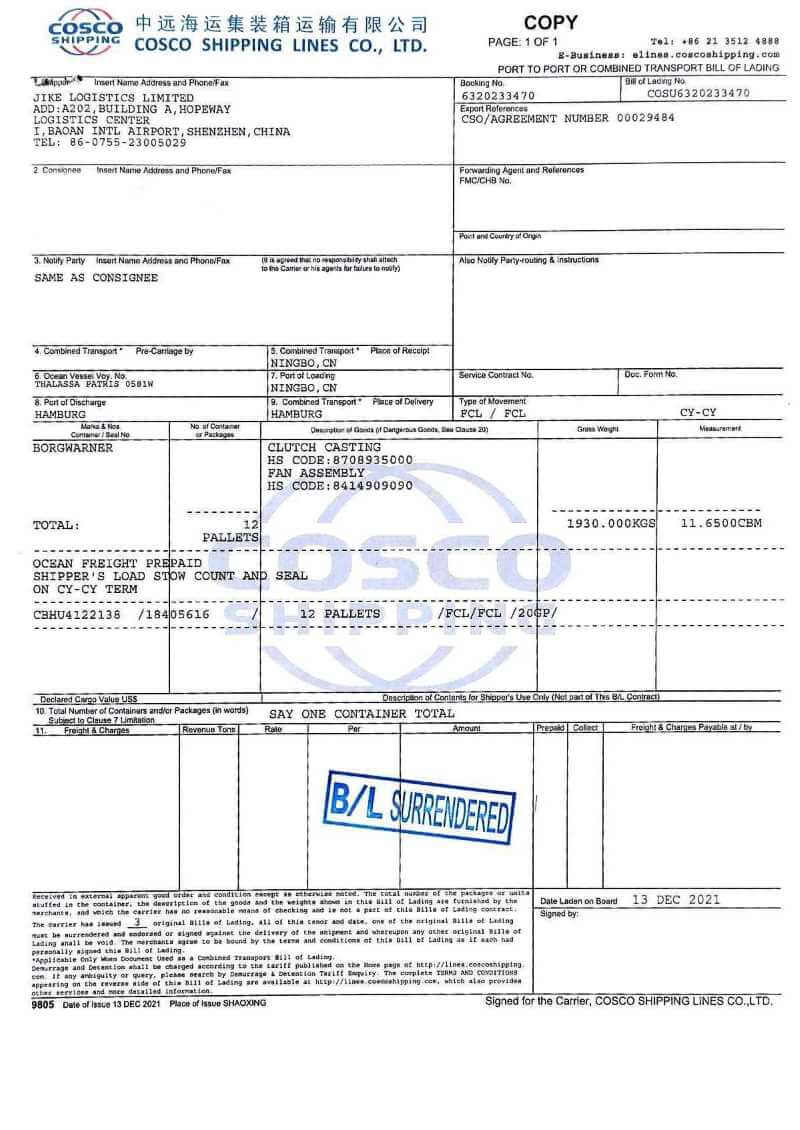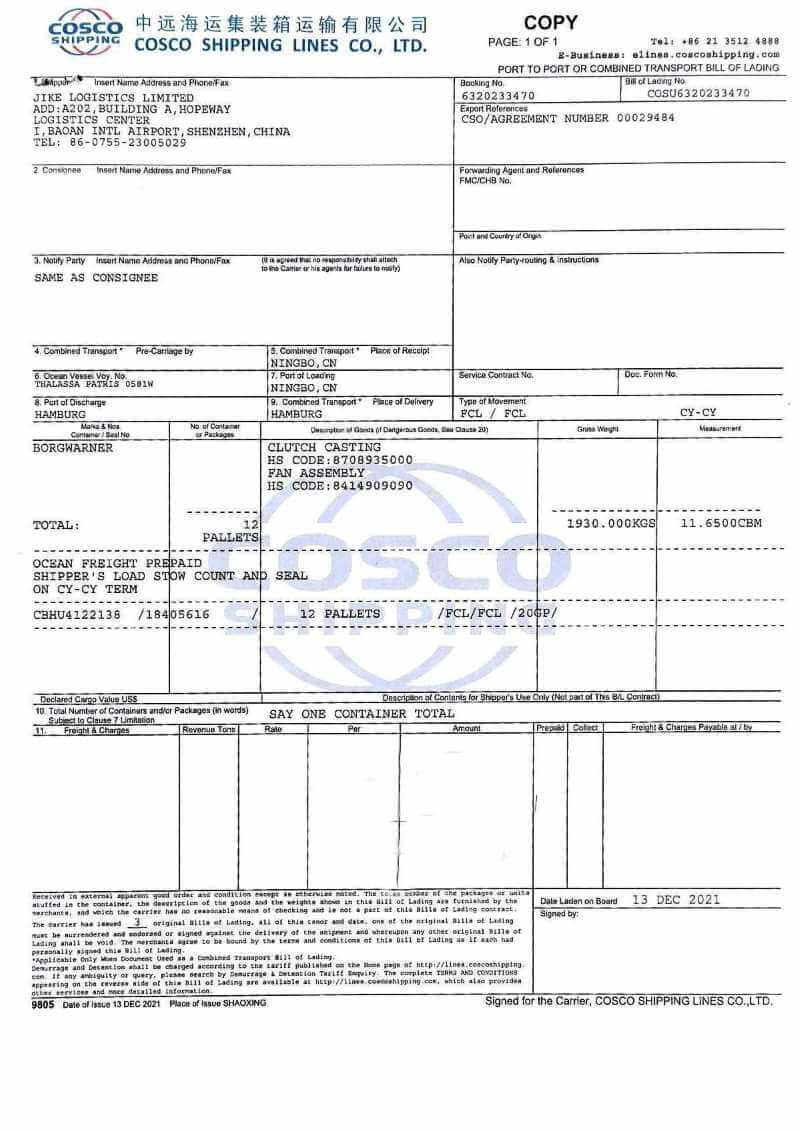2023-02-03
Telex release bill of lading and "sea waybill" are created for the convenience of sea transport, and in the current international container liner transport practice often use. According to the statistics of some container liners in the Sino-Japanese route using documents, according to the number of tickets, the use of bills of lading is still as high as about 90%, the use of Telex release bill of lading has also accounted for about 8%, while the use of sea waybill only accounted for about 2%. However, people in the choice to use " telex release " or the use of sea waybill, often is the cloud, blindly choose. In the study of the choice to use " telex release " or the use of sea waybills, must first clear " telex release " and the basic concept of sea waybills.
Click to learn more about foreign trade
In the case of goods loaded, the shipping company issued a bill of lading, the consignee must deliver a properly endorsed (duly endorsed) of the original bill of lading (in the change of the port of discharge or in other special circumstances, usually a full set of original bill of lading should be delivered) (Note: this is the nature of the bill of lading as a paid securities, that is, the bill of lading on the request to withdraw the right to achieve the bill of lading must be returned as an element), and should also pay all the fees payable, and then in the port of discharge to obtain a bill of lading (Delivery Order, D / O), the withdrawal of goods.
When the consignee is unable to obtain a bill of lading in time, the consignee usually takes delivery of the goods in exchange for a bill of lading on the basis of a guarantee (note: please distinguish between the concept of "bond", which is commonly used in shipping practice, and the concept of "guarantee" in security law). However, the shipping company cannot use the guarantee against a third party (the real consignee holding the bill of lading) because the bill of lading is the document by which the carrier guarantees the delivery of the goods. The terms contained in the bill of lading for the delivery of the goods to the named person, or to the person instructed, or to the holder of the bill of lading, constitute a guarantee by the carrier for the delivery of the goods.
In order to enable the consignee in some can not get the bill of lading in a timely manner, and the shipping company is not willing to deliver the goods in a guaranteed situation to be able to withdraw the goods in a timely manner, the practice has produced the practice of telex release bill of lading. People usually say "telex release" is a narrow concept, that is, the shipper (consignor) will be loaded on board the carrier (or its agent) issued by the full set of original bill of lading returned to the carrier (or its agent), while the consignee (non-nominal bill of lading in the case); the carrier authorized (usually by telex, telegraph and other communications The carrier authorizes (usually by telex, telegram and other means of communication) its agent at the port of discharge to deliver the goods without the consignee producing the original bill of lading (which has been recovered).
Therefore, the legal principle of the telex bill of lading is: in the case of a bill of lading issued by the carrier, the bill of lading can be recovered to deliver the goods (or issue a bill of lading). As the carrier to recover the bill of lading is in the delivery of goods (port of discharge) outside the place (usually in the port of loading), depending on its special circumstances, so recover the full set of original bill of lading. However, the current international conventions, domestic laws (such as the Chinese Maritime Law) and regulations are not defined as " telex release ".
Sea waybill rules
Simpler trade procedures usually attract more people to do business. So too, simpler shipping procedures are an important factor in determining the speed at which world trade develops. When using a sea waybill, it is easier, more timely and safer for the consignee to collect the goods than when using a bill of lading.
With the three functions of the bill of lading, the bill of lading also has the function of a receipt for the goods and the function of proof of the contract of carriage, however, the bill of lading is not a "document of title".
There are, of course, some problems with bills of lading and they do not replace them. For this reason, many shipping companies do not yet have their own sea waybills. However, in some cases an telex bill of lading is applicable and often a sea waybill can also be used.
In shipping practice, often encounter tele-release bills of lading, sea bills of lading and other documents different from the ordinary original bill of lading. What is the difference between them and the general bill of lading, and what is their special purpose?

Telex release bill of lading means delivery by cable. The foreign carrier retains the full set of original bills of lading and notifies the agent at the port of destination. The consignee shall present the printed copy of the original bill of lading and guarantee delivery of the goods. The telex release bill of lading usually has a telex release, surrendered and other words. A "Telex release bill of lading" marked "Surrender" will be picked up by the shipper in accordance with his or her identity at the port of destination, while a consignee marked "Telex release" will receive the telex release bill of lading from a facsimile copy of the telex release bill of lading.

A sea waybill is somewhere between an original bill of lading and an electric bill of lading. That is, it has the function of the original and enjoys the speed of the electric release.
SEAWAYBILL that is, the sea waybill, is proof of the contract of carriage by sea and the goods have been received or loaded by the carrier, the carrier guarantees that the goods will be delivered to the consignee named in the document of non-negotiable documents. It is not a document of title and therefore not transferable. The consignee is not with this but with the notice of arrival to pick up the goods, so the sea waybill consignee to fill in the actual name and address of the consignee. At the same time, some shipping companies will charge telex release fee, but there is no charge for the application of waybill. The safest thing is to make a sea waybill after receiving the money.
The term "Surrendered" or "Telex Release" is commonly seen on the Telex Release Bill of Lading.
In English, the Telex Release Bill of Lading is expressed as "Surrendered BL" or "Telex Release BL," while the Original Bill of Lading is referred to as the original BL.
According to the Oxford Modern Legal Phrasebook, "Surrender" in legal terms means "to give up something." Therefore, when the term "Surrendered" is indicated on the Telex Release Bill of Lading, it signifies that the issuer does not intend to confer the document's rightful function as a property right certificate.
On the other hand, when the term "Telex Release" is specified on the Telex Release Bill of Lading, it indicates that the delivery of the goods under this document differs from that of the original Bill of Lading.
Some people may think that "Surrendered" and "Telex Release" are the same or may not be aware of any distinction between the two. Strictly speaking, there is a difference:
A Telex Release Bill of Lading with the term "Surrendered" implies that, at the destination port, the consignee designated by the shipper should collect the goods upon presenting proper identification.
A Telex Release Bill of Lading with the term "Telex Release" indicates that, at the destination port, the consignee can collect the goods by presenting a faxed copy of the Telex Release Bill of Lading.
No issuance of any original bill of lading
1)The carrier provides a copy of the shipper's bill of lading to the freight forwarder.
2)The freight forwarder faxes this copy to the shipper for confirmation.
3)After confirmation by the shipper, they fill out a Telex Release application and send it to the freight forwarder. (The Telex Release application often includes a statement like: "Please kindly release cargo to Consignee here - below without presentation of the original XXX Bill of Lading." (XXX represents the carrier's name or the freight forwarder's name) - This implies releasing the cargo without submitting the original B/L from XXX company).
4)The freight forwarder forwards the Telex Release application to the carrier.
5)If the carrier agrees to the Telex Release, after loading the cargo, they transmit the Telex Release message or Telex Release number to the shipper through the freight forwarder.
6)The shipper passes the Telex Release message or Telex Release number to the consignee, who can then collect the cargo at the carrier's agent's office at the destination port, presenting the Telex Release message or number along with a copy of the bill of lading.
Telex Release for Shipper's Bill of Lading, and the Freight Forwarder Issues an Original Freight Forwarder Bill of Lading
In this case, the carrier sends a copy of the bill of lading to the freight forwarder for confirmation. The shipper's name is filled in by the consignor, and the consignee's name at the destination port is filled in by the freight forwarder. After confirmation, the freight forwarder applies for Telex Release. If approved by the carrier, the Telex Release message or number is transmitted to the freight forwarder. Finally, the agent of the freight forwarder at the destination port collects the cargo from the carrier's agent.
The operation is similar to the previous type. In this case, the carrier issues the original bill of lading to the freight forwarder, with the shipper as the freight forwarder, and the consignee as the agent of the freight forwarder at the destination port. After confirmation, the freight forwarder at the destination port collects the cargo with the original bill of lading.
Telex Release is conducted between the freight forwarder and the shipper, and the consignee collects the cargo at the destination port with the Telex Release message or number.
Payment conditions based on a letter of credit or collection.
Instructions for a specified bill of lading or a blank bill of lading.
As a carrier, container liner companies have "customer is God" as their service concept, so When the customer requests the use of telex release bill of lading or the use of sea waybills, unless the shipping company does not have its own sea waybill, the shipping company will meet the customer's request However, in the case of carriers, it is not always possible to use the same service. However, for carriers, the option of using the sea waybill is preferred.

Master Bill of Lading VS. House Bill of Lading: What are the differences between these two bills? Learn about their purposes and functionalities.
2023-05-19
We use third-party cookies in order to personalise your experience.
Read our cookie policy